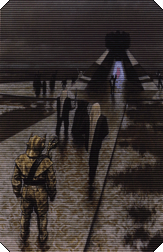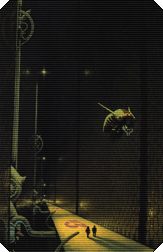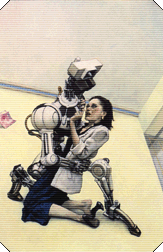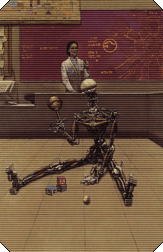I, Robot: The Illustrated Screenplay
by Harlan Ellison
Reviewed by Galen Strickland
Posted March 31, 2001, with later edits
A purchase through our links may earn us a commission.
Sometime late in 1977, Harlan Ellison encountered a film producer in the Warner Brothers studio commissary, and the conversation eventually came around to the fact that Warners had optioned Isaac Asimov's I, Robot but had yet to see an acceptable screenplay. When it became apparent that Harlan was both exceedingly familiar with the stories, and also had a definite idea of how it should be adapted to the screen, he was asked to take a crack at a script. Touching base with Asimov himself on several occasions, Ellison devoted nearly a year to the project, working on it exclusively and putting several other stories and script ideas on hold for the interim. When it was complete and had received Asimov's complete support, Harlan began a series of frustrating meetings with Warners executives. Many changes were suggested, none of which Ellison was willing to implement. As written, his concept of the stories would have been a bold, mature, and complex examination of the life of Susan Calvin, a "robo-psychologist" in the employ of U. S. Robots and Mechanical Men, the world's largest manufacturer of robots.
[PLEASE NOTE: The 2004 film that starred Will Smith was not based on this screenplay, and from what I have read was not even originally based on Asimov's stories. Instead, changes were made to an existing script to add the elements of Asimov's Laws of Robotics and acquire rights to use the title.]
The studio heads, of course, knew exactly what was wrong with the script. It didn't feature cute and comical robots as had become enormously popular the previous year in the original Star Wars film, now known as Episode IV: A New Hope. Nothing Ellison could say was going to alter their perception of the film, so his script was shelved and they went looking for other writers. Several times over the next few years different directors were also approached in connection with the project, and on more than one occasion they asked to see Ellison's script but were informed his version was unacceptable and would not be used. Years later, when it seemed apparent a production based on his script was not likely to be undertaken, Ellison was still anxious for the general SF audience to be able to read and appreciate his work. He was successful in persuading Warner Brothers to allow the screenplay to be printed in a serialized version in Asimov's Science Fiction magazine, and it appeared in the November, December and Holiday issues of 1987. In 1994, Warner Books also issued a hardcover edition of the script, with both color and black-and-white illustrations by Mark Zug.
In his introduction, Ellison expressed the desire for readers who enjoyed the book to contact Warner Brothers and petition them to use his script for a production of the film. This book has been out of print for several years, but you can take this LINK to amazon to search for a used copy. If you can find it you don't have to take my word for it to understand why this is possibly the greatest SF film never made.
A purchase through our links may earn us a commission. Even used copies.
When first informed of the project Ellison correctly surmised the basic mistake other screenwriters had made with their scripts. Since I, Robot is a collection of short stories rather than a continuous novel storyline, most had envisioned it as an omnibus type of film, i.e. an anthology of short vignettes. Even though Ellison also took an episodic approach, his screenplay focused on the character he felt was the most important to the whole saga, that of Susan Calvin. For book publication, Asimov had added connecting passages between many of the stories that related the efforts of a reporter to interview Calvin on the occasion of her retirement from the robot firm for which she had worked her entire adult life. This gave Ellison the idea of emulating one of his favorite films, Citizen Kane, in which a reporter interviews friends and acquainances of Charles Foster Kane following the death of the reclusive tycoon.
An early segment of the screenplay recounts the events of the story "Robbie," with an alteration that replaces Gloria Weston with the young Susan Calvin as the child whose nanny was a robot. It was the devotion of Robbie to young Susan, and her to it, that compells her to pursue a career in robotics. I have read I, Robot several times, and I have also read a few of Asimov's other robot stories, however I have not read them all, which were collected as The Complete Robot in 1982. Ellison used some elements from some of these extra stories in his screenplay, but because of my lack of reading experience with all of the stories I am not sure if some scenes were creations of Ellison himself or based on stories I have not read.
 |
Two different stories in the original I, Robot concerned Stephen Byerly, a lawyer who was suspected of being a robot in disguise and who later entered a career in politics and eventually became chairman of the World Council. Ellison's screenplay begins with the announcement of the death of Byerly, who is described as a chairman of the Galactic Council. Many aspects of Byerly's life had been shrouded in mystery for many years, and an enterprising reporter sets his sights on penetrating these mysteries when he encounters Susan Calvin at the memorial services. Rumors had been rife concerning a possible relationship between Calvin and Byerly, and the reporter figures to uncover truths about the man by probing into the life of Calvin.
She rejects his bid for an interview, so instead he embarks on the task of interviewing co-workers of Calvin's, among them Gregory Powell and Michael Donovan, trouble-shooters for the robot manufacturing firm. In a flashback to their younger days, they tell the reporter of an occasion in which they had observed the ingenuity and strength of will Calvin brought to her profession as robo-psychologist, a discipline which had made her the most knowledgeable authority on the positronic brains of the robots. The story Ellison used for this segment, "Runaround," was one in which Calvin was not featured, however her inclusion in the script version of this story was handled with complete logic.
 |
Another segment of the script is a recreation of the story "Liar." This time the flashback is related by another of Calvin's colleagues, the mathematician Peter Bogert, who is temporarily revived from cryonic suspension for the interview. This is an element I am assuming was a construct of Ellison's that had not appeared in one of the stories, but I may be wrong about that.
The usual instructions for screenwriting is not to include too much description of the scenery, and certainly not camera movements and placement, which is the prerogative of the director and his cinematographer. Thankfully, Ellison has ignored this advice and given an excellent description of this scene. It would have been very easy to visualize it even without Mark Zug's illustrations, but I am glad they were included because they are as masterful an interpretation of Ellison's ideas as Ellison's words are of Asimov's original stories. I have no idea if Harlan had another film in mind when he wrote this scene, but it reminded me of John Carpenter's first film, Dark Star, in which a starship crewman converses with his "dead," cryonically frozen commander.
 |
"Liar" is my favorite of the robot stories, one in which a unknown element in the manufacture of a robotic prototype has rendered the machine capable of reading the minds of its human creators. Herbie, as the robot is known, constrained from harming humans by the restrictions of the Three Laws of Robotics ¹, is forced to lie to them in order to protect them from what it considers information that would harm them psychologically. Even though Herbie knows the reason behind his unusual ability, he witholds this information from Bogert and executive officer Alfred Lanning, since he realizes this information would damage the humans' self-esteem.
When Herbie learns that Susan Calvin harbors an infatuation with another of her colleagues, Milton Ashe, the robot informs her that Ashe is secretly in love with her but is too shy to broach the subject himself. Normally shy and reclusive herself, Calvin eventually begins to believe this lie, but before she is able to open up to Ashe about her feelings he informs her that he is considering marriage to someone else. Devastated by this revelation, Calvin confronts Herbie about the lie. She is able to drive the robot into a catatonic state when it realizes its lies have harmed the humans as much as the truth would have, and thus it has inadvertantly broken the First Law.
One of the Susan Calvin stories not included in I, Robot but that Ellison incorporated into his script is "Lenny." Lenny is another robot prototype which suffers from an error in its manufacture, the error in this case rendering its positronic brain into the semblance of a human infant. All of the robots' brains had been designed for specific purposes, such as off-world mining operations or an intricate manufacturing procedure. Lenny's malfunction occured as a result of a child's random keystrokes on a keyboard inadvertantly left open during a school group's tour of the robot factory. Every official with the company but one feels that Lenny should be destroyed since he would be unable to perform the function intended. Calvin argues in his defense that it is the perfect opportunity to see if a positronic brain could be trained from scratch much as a child learns from its experiences. Her speculation was that such a procedure might result in a multi-purpose, versatile robot capable of learning many tasks. The others relent, and Calvin devotes the rest of her professional life to Lenny's training.
 |
The original story ended there with no indication of whether her experiment was successful or not, but with the implied assumption that anything to which Calvin set her mind would be accomplished. Ellison used this idea as a springboard to tie it into the previously mentioned stories about Stephen Byerly. Toward the end of the screenplay, Calvin finally relents and allows an interview with the crusading reporter. As she tells the story of Lenny it gradually dawns on the reporter what Byerly's great secret had been all along. He was indeed a robot, in fact was the mature Lenny. The most fantastic story of the reporter's career is one he has difficulty accepting himself.
Byerly had been the most successful and respected statesman Earth had ever produced, one who had led humanity into a bold new future that spanned many star systems and had encountered multitudes of other sentient species. To realize that it was a robot that had shaped man's destiny to such a remarkable degree was more than most people would be willing to tolerate, as the hatred of robots was still extremely strong among those who had never ventured off-world where robots were commonplace.
Since reading this screenplay, I have often wondered if some of the ideas presented by Ellison had possibly influenced Asimov in the creation of the series of novels he produced in the 80's which bridged the gap between the robot stories and those of the Foundation series, which had previously not been thematically connected. I have not read all of them either, but one aspect of them that I do know is that Asimov presented the concept that the robots helped create the Galactic Empire as a way to assure the survival of the human species, which the robots felt to be essential in order to literally comply with the First Law.
Regrettably, a film based on Ellison's screenplay may never be produced. Even if another film of I, Robot is ever made using his script as a guideline it would more than likely be re-written by so many other writers, directors and/or producers into such a state as to make it practically unrecognizable to Ellison as his own work, and what is worse it would probably resemble Asimov's stories even less. I was fortunate to be able to obtain this book from the Science Fiction Book Club several years ago, but it is no longer offered by them, in fact at the current time they do not offer any of Ellison's titles and very few of Asimov's either. It is currently available from amazon.com in paperback, plus I am sure you could find it new or used through other online sellers. It is a perfect compliment to the Asimov collection, and it is also an insight into what is really wrong with the production process of Hollywood. This is a film that cries out to be made, just as Ellison envisioned it!
All illustrations from I, Robot: The Illustrated Screenplay are copyright © 1994 by Mark Zug. Please visit his website, browse his other artwork, and if possible buy something or send a donation through PayPal.
Related Links:
My review of Asimov's book I, Robot
My profile page on Harlan Ellison
¹ The Three Laws of Robotics are:
1. A robot may not injure a human being, or, through inaction, allow a human being to come to harm.
2. A robot must obey orders given it by human beings except where such orders would conflict with the First Law.
3. A robot must protect its own existence as long as such protection does not conflict with the First or Second Law.
We would appreciate your support for this site with your purchases from
Amazon.com and ReAnimusPress.